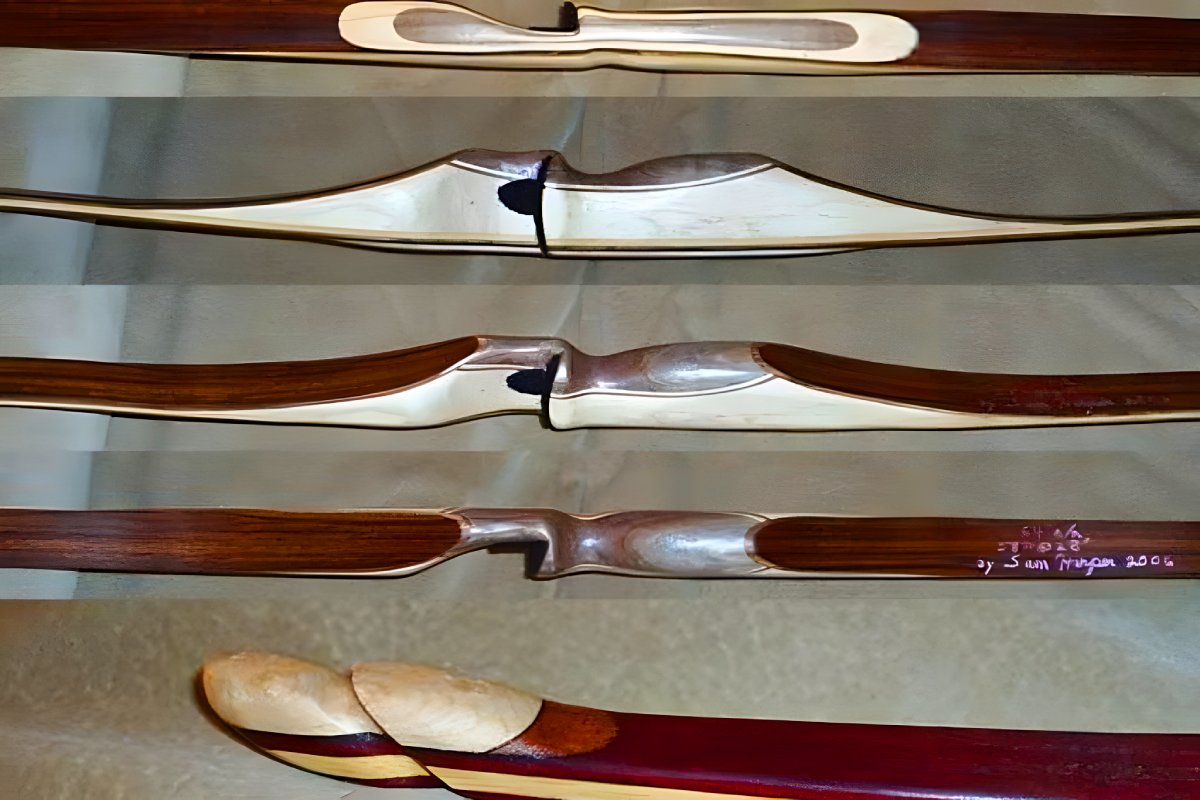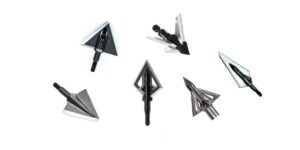Special Thanks to Sam Harper for allowing us to republish his tutorials and build along instructions. His expertise and knowledge in the bow-making field have greatly benefited many readers, and we are grateful for his generous permission.
You can back a bow with almost anything, but some things are better than others. The primary purpose of backing a bow is to create a back that effectively has one growth ring so that it isn’t likely to lift a splinter.
The back of the bow is under tension, and the smallest splinter can cause the bow to fail. Anything that prevents a splinter from lifting will work as a backing.
Backing a bow allows you to use wood where the rings are violated, the grain isn’t perfectly straight, the wood is weak in tension, or just to be sure.
There are three different kinds of backings–those that prevent splinters from lifting, but nothing more, those that actually do work, and sinew.
Contents (Jump to Topic)
ToggleSinew
I’ve never actually used sinew myself, but it doesn’t get more traditional than sinew. I put it in its own category, because it’s unique in some ways.
When you apply sinew to a bow, it adds a little weight, because as it dries, it shrinks, pulling the bow into more of a reflex.
From what I have read, sinew is a real pain to apply. You have to soak it in hide glue, squeeze it out, and apply it in a brick pattern on the back of the bow. It needs some kind of water-proof finish, or else it isn’t water proof.
Once it’s applied and dried, it adds quite a bit of durability to a bow. You can make a bow shorter, because the limbs will be able to withstand more bend.
In the book, American Indian Archery, Reginald Laubin says that when you back an osage bow with sinew, it isn’t even necessary to remove the sapwood first. They perform just as well with the sapwood on.
You could buy sinew from Three Rivers Archery, ebay, or other traditional archery places, but I think there are probably cheaper ways to get it.
Ask your hunting buddies to let you have the sinew from the deer they shoot. It’ll only be about six inches, so you’ll need a few of them to back one bow. You might also look in the phone book under “taxidermy.”
Taxidermists just throw that stuff away. Ask them if they have any or how you might get some.
Backings to Prevent Splinters from Rising
These are great to use on board bows, because the grain in board bows is almost never perfectly straight. You’d be amazed at what you can use to back a bow. Almost anything will work, but some things are better than others.
Silk and linen
You can get silk and linen for dirt cheap at garage sales or the Goodwill. Some people say you should check out the dresses at Goodwill in search of silk. I have had much more luck looking at women’s pants.
I have found all kinds of pants that are 100% silk or 100% linen, and they usually something like $3 each. Sometimes they can be as much as $10. You can back several bows from one pair of pants.
I apply silk and linen with Titebond II. I just squeeze a stream of glue all down the back of the bow and spread it with my finger.
Then I use a squeeze clamp at the tip of the bow to hold one end of the cloth, and smooth it down toward the handle with my finger. Then I do the same from the other end so that it overlaps in the handle area.
Let it dry at least over night. Once it’s dry, you can use a file, belt sander, or razor blade to trim off the excess.
Drywall Tape (sheetrock tape–same thing)
This is another cheap way to back a bow, but it’s kind of ugly in my opinion. You just squeeze a stream of glue down the back of the bow, spread it with your finger, and put a layer of drywall tape on.
Smooth it down with your fingers from the handle out to the tips. There should be enough glue so the mesh is saturated. I wait about 10 or 20 minutes and put another layer. Then I put a third layer. Anything over that is probably overkill.
There’s a couple of things you should know about this method. First, it’s fiberglass, and you can get fiberglass splinters in your fingers, though that hasn’t happened to me much. It’s better to wear latex gloves while you apply this backing.
Also, this method uses a lot of glue, and glue adds weight to the bow, which slows it down a little. One other thing–it’s a little more of a pain to trim the edges once it has dried than cloth backings. You can do it with a razor blade, a file, or a belt sander. It’s actually pretty easy with a belt sander.
Just be sure to wear gloves when you do it, because fiberglass can cause itchies. Sand the edges when you’re done.
Since it’s so ugly, I usually spray paint it. That helps a lot.
Fiberglass Cloth and Epoxy
Fiberglass cloth is not the same thing as drywall tape. It’s more like a cloth, and it’s not full of holes. You can get it at auto parts stores, Walmart, and boat stores.
If you apply it with Smooth On epoxy or BowGrip, then sand it after it cures, it will become transparent when you put a finish on it. That’s what I like about it. It makes a really durable backing, but you can still see the wood through it.
I used it on an Eastern Red Cedar English Longbow because ERC is brittle, but I didn’t want to cover it up with a rawhide or linen backing. I also used it to patch a crack on the back of an Osage self-bow, and you can barely even tell there’s a patch.
Paper
That’s right, paper! You’d be amazed at how strong paper is. Brown paper bags seem to be the most popular.
Apply it just like you would one of the cloth backings above. Use Titebond II. I’ll bet you could even use one of those rolls of paper like they use in cash registers to print receipts, though I’d probably use two layers of it.
Rawhide
Rawhide shrinks as it dries. Because of that, I don’t understand why it doesn’t work just like sinew. Maybe it doesn’t shrink quite as much. Anyway, rawhide needs to be good and thin for it to work. It should be applied with hide glue.
Denim
Demin isn’t that popular, because it stretches too much. Silk and lenin don’t stretch much at all. It still works, though. It’s also heavier than silk. The advantage is that it’s easier to find and it’s cheaper than silk and lenin.
You can find it at just about any garage sale, and probably get a pair of pants for a dollar that will back several bows. Better yet, you probably have an old pair of pants yourself. If not, surely you have a friend with an old pair of pants they don’t wear anymore.
Backings that do work
These are backings made of wood or bamboo. The advantage of using them is that when you apply them, you can glue reflex or a reflex/deflex shape, and it will hold. You can use Titebond II, but Urac or Smooth-on is better.
Titebond II shrinks when it dries, and unless you have a perfectly flat surface, you’ll get gaps in the glue line. Urac and Smooth-on are better at filling gaps.
Hickory
Hickory makes a good backing because (1) it’s very strong in tension, and (2) it grows very straight, so it’s easy to get a piece with straight grain, and (3) hickory is hard to break even when the grain isn’t perfectly straight.
Since it’s so strong in tension, it needs to be thinned below 1/8″. Some people go as low as 1/16″. Murray Gaskins sells hickory backings for about $12 a piece. It’s a little pricey, but the advantage is that it’s already cut to size, and the grain is straight.
Murray knows what he’s doing. They come in 1/8″, so they just need to be thinned a little. I do that with a belt sander. You could also buy a hickory board at a lumber yard if you can find it, and cut your own. Just be sure you pick a board with very straight grain.
The advantage of hickory over bamboo is that there are no nodes, and you don’t have to go through the difficulty of flattening it like you do bamboo. With no nodes, it’s easier to glue, and it’s easier to work with.
Bamboo
Murray Gaskins also sells bamboo backings, but they aren’t flattened all the way. It’s much cheaper to buy it from Master Gardens or Franks. Bamboo is also amazingly strong in tension, so it needs to be good and thin so it doesn’t overpower the belly wood.
Bamboo is better-looking than hickory, but a little more difficult to prepare for backing. The advantage of it is that the grain is always guaranteed to be straight.
The difficulty with gluing it is that it’s rounded a little on the back, which makes it hard to put the clamps on. One way to avoid that problem is to use the inner-tube method of gluing up a bow. I’ll have to post another article about techniques for flattening bamboo and getting it ready for gluing.
People are trying new things all the time, so it never hurts to experiment.
Disclaimer: Sam Harper owns the rights to this article’s images and written content.







Conversation | 8 comments:
I do have a question about this. I have had a really entry built 72″ poplar bow snap in the middle of the upper limb. It was clearly a compression failure. Bow was backed with fiberglass dry wall tape – 4 layers. 40lb at 31″ draw. It seems to me that substantial bow backing forces more compression of the wood on the belly of the bow than would occur were the bow unbacked since it resists the tension motion of the front of the bow during draw. Adding tensile strength effectively. Thoughts?
Absolutely, adding layers of fiberglass tape to the back of your bow does boost its tensile strength, which is great for preventing too much stretch when drawing the bow. This technique is especially useful for woods that aren’t naturally tough against stretching. But, there’s a catch: it puts extra compression stress on the bow’s belly. Since poplar is a softer wood, it might struggle under this extra pressure, especially if there are imperfections in the wood. This increased compression can unfortunately lead to failures like the one you’ve seen. It’s all about finding the right balance between the bow’s backing strength and the wood’s natural properties.
I have a good piece of ash. 72″X2″X2″. I plan to make a deflex/reflex longbow. I am an old fart and pulling 60 pounds is now uncomfortable. To comply with hunting regs I plan to make it in the low 40’s.
I want to back the bow. Do I build in the deflex and reflex before backing, that would seem logical to me but I do not know. I want the bow to be safe and I am told that backing will contain most splinters if the bow fails. Is this true?
I have another longbow I made with an ash board, and backed it with Titebond III and soaked rawhide. Wrapped it with saran wrap and wrapped it tightly with a stretchy material. Worked great. It is not pretty!
I reflexed the tips on that bow using a heat gun and a homemade bending rig, with a post that limited the bend, so both would be bent evenly. Also used masking tape on the edges of the limbs to keep them free from glue. The bow ended up at 50# and it worked fairly well. But had no one who could reallt critique the build.
Looking for answers and comments
You’re definitely firing on all cylinders here, Phil. Nothing wrong with your approach and not too much I can tell you I think.
Definitely build out your deflex/reflex into the limb before backing it. The backing will contain splinters on a blowout unless its really, really severe. With a 40lb bow I wouldn’t worry about blow out. As long as you have a healthy, tight, straight grain stave, of course. No amount or type of backing can save a bad stave.
Titebond III and rawhide works great, you could also use hide glue. You can make it look pretty, it just takes patience and a nice even piece of hide. I like a finished hide better asthetically. Remember you can let it set for a half hour or so and then take your wrap off and make adjustments (work any air out if needed) and then rewrap and let dry.
Like I said there isn’t much I could add to your journey. I hope you harvest something with it! Not much better a feeling, thats for sure.
Thanks Alex.
I was unaware that once wrapped, about a half hour later I could unwrap and try to make things prettier. I think you would not want to take a lot of time re-adjusting the backing and squeezing out any air?
I appreciated your input.
Phil
You sure can, Phil. Depending on temp/humidity you may want to push it to an hour so it has time to set a little bit. You can take as long as you’d like readjusting it, honestly. I mean within limitations I suppose but it shouldn’t take you that long to make your adjustments. Not enough to worry, anyway. Hope I helped a bit!
I have a 30# wood bow which is probably 100 years old. I got the bow from my aunt which she used in school back then when archery was offered to women. I have used that bow in the 1960’s then I opted to use recurve fibreglass bows in its place. Sixty four year later I relocated the bow in my aunt’s house and I used it for a while until it snapped along the upper limb down to the middle. I was able to duct tape the broken area so as not to lose the shattered segments. Can I glue back the bow back to its original form and reuse it or am I wasting my time.
If you snapped it in two it sounds unrecoverable Patrick. If it was a splinter I’d say you’re not wasting your time but sadly a solid break glued up just isn’t going to ever stand up to working condition. Best it’ll do is look pretty on the shelf for some history, but maybe that’s all it needs?